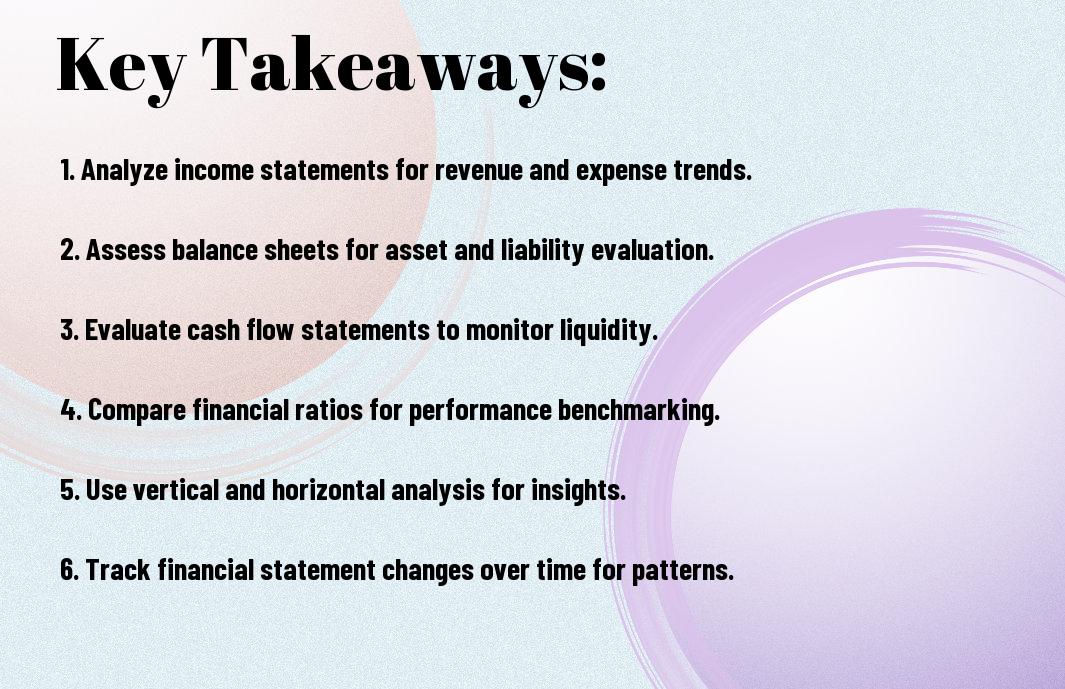It’s imperative to understand how to leverage financial statements to gain valuable insights into your business’s performance. By analyzing balance sheets, income statements, and cash flow statements, you can make informed decisions that drive growth and efficiency. This guide will walk you through the key components of each statement and provide practical tips on how to interpret the data effectively, empowering you to enhance your strategic planning and operational management.
Key Takeaways:
- Understand the primary financial statements: Familiarize yourself with the balance sheet, income statement, and cash flow statement as they provide necessary insights into a company’s financial health.
- Analyze financial ratios: Utilize ratios such as liquidity, profitability, and debt management to gauge performance and compare with industry benchmarks.
- Trend analysis: Look at historical financial data to identify patterns and trends over time, helping to forecast future performance.
- Evaluate operational efficiency: Assess metrics like gross margin and operating margin to understand how well the business is managing its resources.
- Consider external factors: Incorporate economic conditions and industry market trends to enhance the analysis of financial statements and make informed decisions.

Understanding Financial Statements
A financial statement serves as a formal record of the financial activities of your business. These statements are vital tools that provide insights into your company’s profitability, liquidity, and operational efficiency. By evaluating them, you can make informed decisions, enhancing your strategic planning and business growth.
Balance Sheet
By reviewing your balance sheet, you can assess your business’s financial position at a specific point in time. This statement summarizes your assets, liabilities, and equity, allowing you to understand what you own and what you owe. It helps you gauge your company’s solvency and stability.
Income Statement
For analysis of your business’s profitability over a specific period, the income statement is invaluable. It details your revenue, expenses, and net income, providing insight into how effectively your business generates profit. This enables you to identify trends and areas that may require improvement.
Sheet analysis of your income statement allows you to track performance metrics such as gross profit margin and operating income. By comparing these figures over time or against industry standards, you can evaluate your business efficiency and overall financial health, facilitating better strategic decisions to increase profitability.
Cash Flow Statement
With the cash flow statement, you can monitor the inflow and outflow of cash within your business. This statement breaks down cash activities into operating, investing, and financing activities, providing a comprehensive overview of your liquidity and cash position.
And analyzing your cash flow statement reveals patterns in your cash management and helps ensure your business can meet its financial obligations. By understanding your cash flow, you can make informed decisions about investments, manage expenses effectively, and enhance your business’s financial flexibility.
Analyzing Financial Performance
Some of the most effective ways to evaluate your company’s financial health include analyzing key financial statements such as the income statement, balance sheet, and cash flow statement. By engaging with resources like Business Analysis Valuation: Using Financial Statements (…), you can better understand how to leverage these documents for a comprehensive business analysis.
Key Ratios and Metrics
Below, you will find that key ratios and metrics serve as vital tools in assessing your company’s performance. These include profitability ratios, liquidity ratios, and solvency ratios, which provide insights into how well your business generates profit, manages its cash, and sustains its financial obligations. Analyzing these metrics regularly can help you make informed decisions about your operations and strategic direction.
Trend Analysis
Between periods, trend analysis allows you to see patterns in your financial data over time. By evaluating historical data and comparing financial statements from different periods, you can identify growth trends, fluctuations, and potential concerns in your business operations. This facilitates long-term strategic planning and aids in forecasting future performance.
Metrics play a significant role in this analysis, as they can reveal insights about your business’s direction and future potential. For instance, examining revenue growth trends alongside expense trends can provide a clear picture of overall profitability and operational efficiency. By continuously monitoring these trends, you can adjust your strategies and make proactive decisions that align with your business goals.
Comparing Against Industry Standards
All businesses must measure their performance by contrasting their financial statements with industry standards. This comparison provides context to your financials, helping you identify areas of strength or concern. Familiarizing yourself with industry benchmarks will enable you to set realistic goals and improve operational efficiency. For more details, check out How to Read Financial Statements: A Beginner’s Guide.
| Metric | Industry Standard |
|---|---|
| Gross Margin | 20% – 40% |
| Net Profit Margin | 10% – 25% |
Benchmarking
Benchmarking allows you to evaluate your company’s performance against competitors and industry leaders. By identifying best practices, you can adopt strategies that enhance your financial position and operational efficiency. Understanding where you stand in the market enables you to make informed decisions that drive growth.
Industry Ratios
Behind every financial decision, there are key industry ratios that inform your business analysis. These ratios help you understand how well the company performs in comparison to peers. By examining liquidity, profitability, and efficiency ratios, you can gauge where enhancements can be made to strengthen your financial standing.
And analyzing these ratios over time allows you to spot trends and shifts in performance. This ongoing analysis fosters strategic adjustments and aids in preventing potential financial pitfalls. Regularly monitoring these metrics will keep you informed and prepared to respond to industry changes effectively.
Using Financial Statements for Decision-Making
Unlike a casual business overview, financial statements provide you with critical insights that are important for making informed decisions. Their detailed figures highlight your company’s profitability, liquidity, and overall financial health. By regularly analyzing these statements, you can confidently strategize and allocate resources effectively, ensuring that your business remains competitive and poised for growth. Utilizing these insights equips you to spot trends, evaluate potential risks, and seize new opportunities, allowing for proactive management of your organization.
Budgeting and Forecasting
Around your business’s financial landscape lies the important practice of budgeting and forecasting. Using financial statements, you can create realistic budgets by analyzing past performance, predicting future revenues and expenses, and identifying necessary adjustments. This continuous monitoring allows you to track your financial progress, ensuring that you remain on course towards your strategic objectives.
Investment Analysis
Above all, investment analysis is a pivotal process that helps you evaluate the viability of new projects or investments. Access to your financial statements enables you to compare potential investments with your company’s current state and future projections.
Analysis of your financial statements allows you to assess return on investment (ROI) and identify which opportunities provide the best potential for growth. By scrutinizing key metrics such as net profit margins and cash flow, you can make sound investment choices that align with your strategic objectives. Furthermore, understanding your financial position enables you to prioritize investments that enhance your company’s value, ensuring that every dollar spent contributes positively to your bottom line.
Common Pitfalls in Financial Analysis
To effectively leverage financial statements in business analysis, it’s vital to avoid common pitfalls that can lead to misinformed decisions. Whether it’s misinterpreting data, overlooking qualitative factors, or focusing excessively on past performance, navigating these issues will enhance your analytical skills and ultimately drive better outcomes for your business.
Misinterpretation of Data
Before submerging into financial analysis, ensure you fully understand the context behind the numbers. Misinterpretation can arise from failing to consider factors such as seasonality or external market conditions that may skew the data. Take time to review accompanying notes and management discussions to gain a comprehensive view.
Overlooking Qualitative Factors
Against a backdrop of quantitative analysis, you might inadvertently dismiss qualitative factors that play a significant role in a company’s performance. These elements can include management effectiveness, market reputation, and industry trends. Keeping these factors in mind will provide a well-rounded understanding of your business’s health. Consider these points:
- Evaluate the strength and credibility of leadership.
- Analyze market conditions and customer sentiment.
- Consider competition and regulatory environment.
After incorporating qualitative insights, you will have a clearer picture of the overall performance and potential risks your business faces.
Indeed, recognizing the importance of qualitative factors adds depth to your analysis. As you assess financial statements, ensure you consider how non-numeric elements influence performance and decision-making. A few things to note include:
- The track record of innovation and adaptability within the organization.
- Employee satisfaction and its impact on productivity.
- Long-term strategic goals and alignment with current operations.
After evaluating both quantitative and qualitative aspects, you will enhance your analytical process, leading to more informed, strategic decisions for your business.

Tools and Software for Financial Analysis
After understanding the fundamentals, the right tools and software can significantly enhance your financial analysis. There are various options available that cater to different analysis needs. For a deeper investigate effective methods, visit Analyzing Financial Statements: Key Metrics and Methods.
Financial Analysis Software
One of the most effective ways to streamline your financial analysis is through specialized software. These applications allow you to automate calculations, generate various financial reports, and visualize data trends, making your analysis less time-consuming and more accurate.
Spreadsheet Strategies
Against a backdrop of advanced technology, traditional spreadsheet programs remain highly effective tools for financial analysis. They offer flexibility and support a wide range of calculations, allowing you to create customized models tailored to your business needs.
Plus, spreadsheets give you the ability to easily update data and adjust financial models as your situation changes. Their familiar interface, along with powerful functionalities like pivot tables and formulas, makes it easy to analyze trends over time, forecast future performance, and perform ‘what-if’ scenarios, enhancing your overall financial decision-making process.
Conclusion
Drawing together your insights from financial statements is necessary for informed business analysis. By examining the balance sheet, income statement, and cash flow statement, you can gain a comprehensive view of your company’s financial health. Use these documents to identify trends, assess performance, and make strategic decisions that align with your goals. By regularly analyzing these statements, you empower yourself to navigate challenges and seize opportunities in your business environment.
FAQ
Q: What are financial statements and why are they important for business analysis?
A: Financial statements are formal records of the financial activities of a business, person, or other entity. They provide a summary of the financial position, performance, and cash flows over a specific period of time. The primary financial statements include the income statement, balance sheet, and cash flow statement. They are important for business analysis as they help stakeholders assess the profitability, liquidity, and overall financial health of a business, enabling informed decisions regarding investments, operations, and strategies.
Q: How can I interpret financial statements for effective business analysis?
A: To interpret financial statements effectively, start by understanding each statement’s purpose: the income statement shows profitability; the balance sheet reflects the company’s assets, liabilities, and equity at a point in time; and the cash flow statement details the cash inflows and outflows. Look for key metrics such as revenue growth, profit margins, debt-to-equity ratios, and liquidity ratios. Comparative analysis against industry benchmarks and historical data can provide deeper insights into trends and performance. Additionally, ratio analysis can help identify areas that may require attention or improvement.
Q: What tools or techniques can I use to enhance my analysis of financial statements?
A: Various tools and techniques can enhance the analysis of financial statements. Spreadsheet software allows for creating customizable models for projections and ratio calculations. Financial ratios, like return on equity (ROE) and current ratio, can be used to gauge performance and efficiency. Trend analysis helps you identify patterns over time, while horizontal and vertical analysis breaks down the financial statements to understand the composition and changes. Additionally, industry-specific software can assist in data analysis and provide benchmarking options against competitors.

